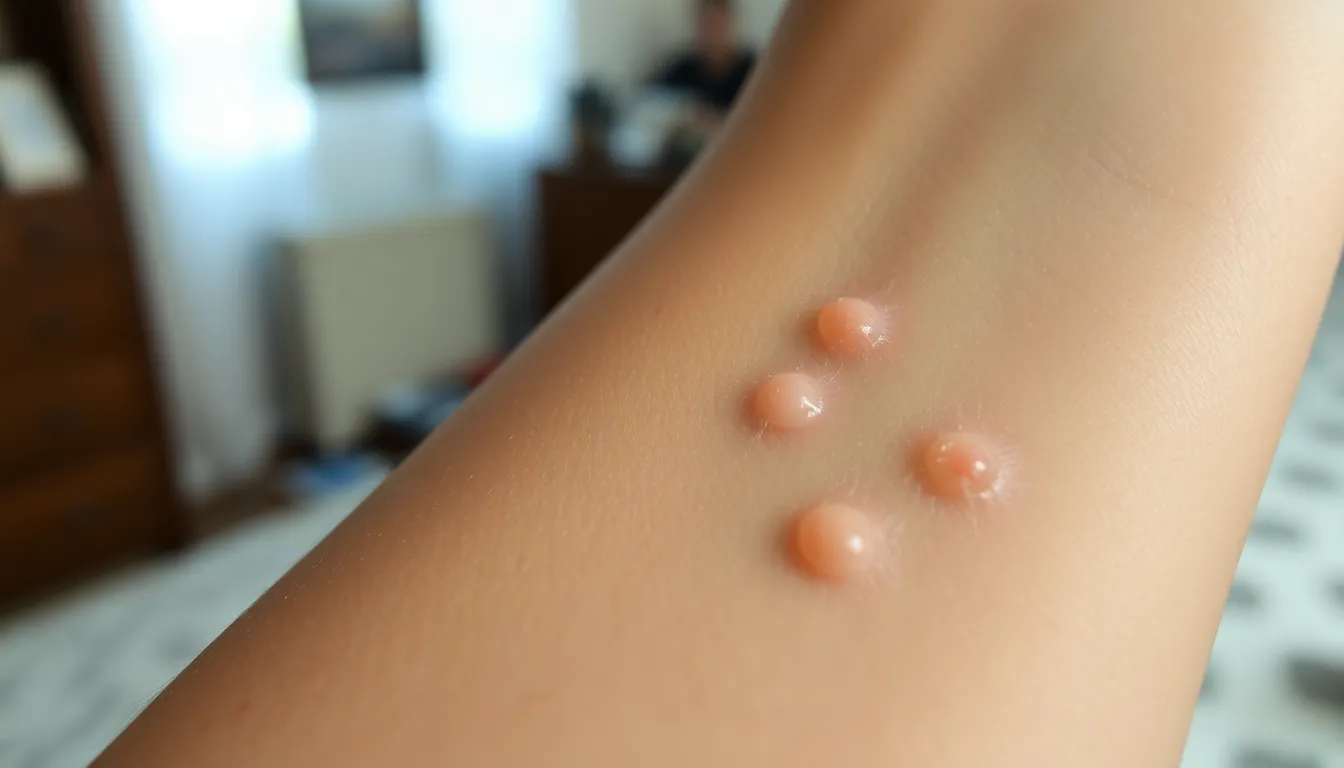Bed bug bites can be a source of confusion and concern for many. These tiny, elusive pests often leave behind telltale signs that can easily be mistaken for other insect bites or skin conditions. Understanding what bed bug bites look like is crucial for anyone dealing with an infestation or simply wanting to stay informed.
Typically, bed bug bites appear as small, red, raised welts on the skin, often grouped together in a line or cluster. They can be itchy and uncomfortable, leading to further irritation if scratched. By recognizing these distinct characteristics, individuals can take the necessary steps to address the problem and seek effective solutions.
Table of Contents
ToggleUnderstanding Bed Bugs
Bed bugs (Cimex lectularius) are small, elusive insects that thrive in human environments. These pests often reside in and around sleeping areas, including mattresses, box springs, and bed frames. Their nocturnal nature makes them difficult to detect, as they feed on the blood of their hosts while they sleep.
Recognizing bed bug bites is crucial for timely action. Bed bug bites occur as small, red, raised welts that may develop into larger, inflamed areas. These bites typically appear in clusters or in a linear formation, often resembling the path bed bugs take while feeding. The itching and discomfort associated with these bites can lead to secondary skin infections if scratched.
Bed bug bites generally occur in exposed areas of the body, such as the arms, legs, neck, and face. An individual’s reaction to the bites varies based on factors like sensitivity, previous exposure, and overall health. Most reactions manifest within one to two days, but some individuals may not exhibit any symptoms at all.
Prompt identification of bed bug bites can help prevent further infestations. It is essential to inspect sleeping areas and surrounding furniture for signs of bed bugs, including shed skins, fecal spots, and blood stains on linens.
Symptoms of Bed Bug Bites

Bed bug bites produce distinct symptoms that help identify potential infestations. Recognizing these signs is vital for effective treatment and prevention.
Physical Appearance
Bed bug bites typically appear as small, red, raised welts on the skin. These welts often cluster together or form a linear pattern, resembling other insect bites. The bites may become swollen and inflamed, particularly if scratched. In some cases, blisters can develop, causing further discomfort. The bites can occur on exposed areas, including the arms, legs, neck, and face, appearing anywhere skin is in contact with infested bedding or furniture. Timing of symptoms varies; reactions may emerge within one to two days after the initial bite.
Itching and Discomfort
Itching usually accompanies bed bug bites, causing significant discomfort. The welts can feel intensely itchy for several days, leading to the temptation to scratch, which may exacerbate irritation. Scratching can also increase the risk of secondary infections, so it’s crucial to manage the urge. Over-the-counter antihistamines or hydrocortisone creams can provide relief from itching and inflammation. Awareness of the symptoms and prompt action can mitigate the discomfort associated with bed bug bites.
Identifying Bed Bug Bites
Identifying bed bug bites is critical for prompt treatment and prevention. Recognizing their distinct characteristics helps in distinguishing them from other insect bites.
Comparison with Other Insect Bites
Bed bug bites can resemble bites from mosquitoes, fleas, or ants. Unlike mosquito bites, which are typically solitary, bed bug bites often appear in clusters or a linear pattern. Flea bites tend to be concentrated around the ankles and lower legs, while bed bug bites can occur anywhere on the body. Ant bites are generally more painful and cause immediate redness and swelling. Understanding these differences aids in accurate identification and appropriate response.
Patterns and Distribution on the Body
Bed bug bites usually manifest in specific patterns. Commonly found on exposed areas, these bites appear on the arms, legs, neck, and face. Bites may cluster in threes or form a straight line, a characteristic known as the “breakfast, lunch, and dinner” pattern. This distribution results from bed bugs feeding in a series of bites. Affected individuals often experience symptoms like itching, redness, and swelling, which can help in identifying the cause. Knowing these patterns assists in recognizing potential infestations early.
Treatment Options for Bed Bug Bites
Effective treatment options exist for bed bug bites, focusing on alleviating discomfort and preventing complications. Individuals can pursue both home remedies and medical treatments to address their symptoms.
Home Remedies
- Cold Compress: Applying a cold compress directly to the bite site reduces swelling and numbs the area, providing immediate relief from itching.
- Aloe Vera: Utilizing aloe vera gel can soothe inflammation and promote healing due to its anti-inflammatory properties.
- Oatmeal Paste: Mixing oatmeal with water to form a paste offers relief by reducing itching and irritation when applied to the skin.
- Baking Soda: Creating a paste with baking soda and water can help alleviate itching and irritation.
- Honey: Dabbling honey on the bites can aid in reducing inflammation and preventing infection because of its antimicrobial properties.
Medical Treatments
- Antihistamines: Over-the-counter antihistamines like diphenhydramine can provide relief from itching and swelling caused by allergic reactions to bites.
- Hydrocortisone Cream: Applying 1% hydrocortisone cream can alleviate redness and inflammation associated with bed bug bites.
- Prescription Medications: In cases where severe reactions occur, healthcare providers may prescribe stronger corticosteroids to manage symptoms effectively.
- Antibiotics: If secondary infections develop due to scratching, antibiotics may be necessary to address bacterial infections.
Prompt and appropriate treatment helps manage bed bug bite symptoms and reduces the risk of further complications.
Prevention Tips for Bed Bug Bites
Preventing bed bug bites involves a proactive approach to reduce infestations and protect sleeping environments. Implement the following strategies to minimize the risk of bites.
- Inspect bedding regularly: Check mattresses, sheets, and pillows for signs of bed bugs, including dark spots from fecal matter or tiny blood stains.
- Use protective covers: Encase mattresses and pillows in bed bug-proof covers. These covers create a barrier, preventing bed bugs from accessing the bedding.
- Reduce clutter: Declutter living areas, especially around beds and sleeping areas. Less clutter provides fewer hiding spots for bed bugs.
- Vacuum frequently: Vacuum carpets, rugs, and upholstery regularly. Use a vacuum with a HEPA filter to capture bed bugs and their eggs effectively.
- Seal entry points: Inspect and seal cracks, crevices, and other potential entry points in walls, baseboards, and furniture. This measure reduces the odds of bed bug infiltration.
- Wash bedding often: Wash sheets, pillowcases, and blankets in hot water, ideally at temperatures above 120°F (49°C). Regular washing eliminates bed bugs and eggs.
- Be cautious when traveling: Inspect hotel rooms for bed bugs before unpacking. Place luggage on luggage racks instead of the floor or bed.
- Monitor secondhand items: Examine used furniture and clothing carefully before bringing them into the home. Treat or quarantine items as needed to eliminate bed bugs.
- Seek professional help: If an infestation occurs, contact pest control experts. Professionals can provide effective treatments to eliminate bed bugs and prevent future occurrences.
Using these prevention tips helps create a more secure sleeping environment and reduces the risk of bed bug bites.
Recognizing bed bug bites is vital for effective treatment and prevention. Their distinct appearance and clustering patterns help in identifying an infestation early. With the right knowledge and proactive measures, individuals can minimize discomfort and reduce the risk of further complications. Implementing preventive strategies and seeking timely treatment ensures a safer sleeping environment. Staying vigilant and informed is key to keeping bed bugs at bay.




